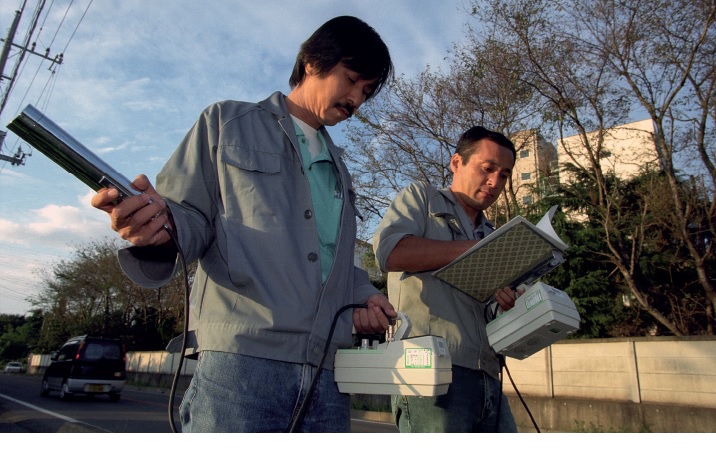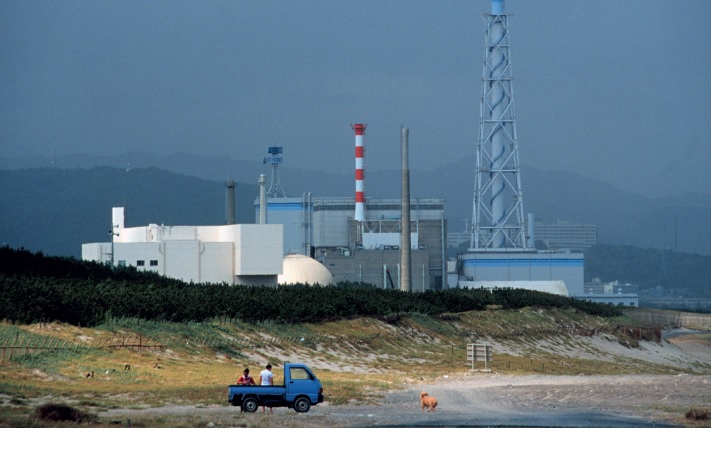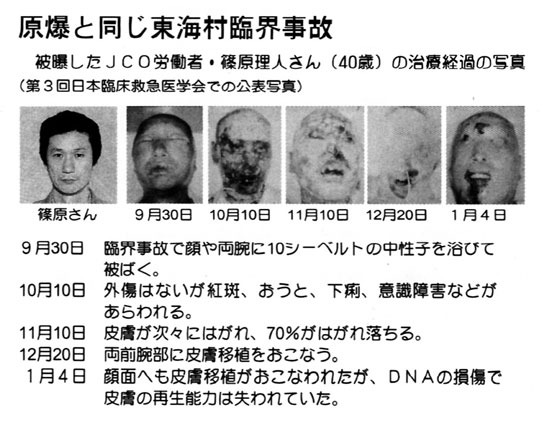
写真(東海村で放射能測定を行う人達) 出典はGreenpeace / Andrew MacColl
1999年に茨城県の東海村で原子力事故が発生しました。
上記ウィキペディアのリンクから、事故の概要部分を引用します。
「1999年9月30日、JCOの核燃料加工施設内で核燃料を加工中に、ウラン溶液が臨界状態に達し核分裂連鎖反応が発生、この状態が約20時間持続した。これにより、至近距離で中性子線を浴びた作業員3名中、2名が死亡、1名が重症となった他、667名の被曝者を出した。」
利益優先・安全軽視の会社方針により杜撰で危険な作業をしていたのが事故原因です。近くで被爆した作業員は急性放射性被爆により亡くなられました。
この事故では、日本の原子力史上初の刑事責任も問われています。上記ウィキペディアのリンクから引用します。
スポンサーリンク
「この事故では、同時に会社側の刑事責任も問われた。事故から約1年後の2000年10月16日には茨城労働局・水戸労働基準監督署がJCOと同社東海事業所所長を労働安全衛生法違反容疑で書類送検、翌11月1日には水戸地検が所長の他、同社製造部長、計画グループ長、製造グループ職場長、計画グループ主任、製造部製造グループスペシャルクルー班副長、その他製造グループ副長の6名を業務上過失致死罪、法人としてのJCOと所長を原子炉等規制法違反及び労働安全衛生法違反罪でそれぞれ起訴した。 2003年3月3日、水戸地裁は被告企業としてのJCOに罰金刑、被告人6名に対し執行猶予付きの有罪判決を下した。
なお、被害者でもある作業員Cは製造グループ副長としての現場責任を問われ有罪判決を受けた。」
当たり前ですが、厳しく責任追及がなされたんですね。福島原発事故を起こした東京電力は誰も裁かれていませんが・・・・。

写真(東海村の核燃料加工施設) 出典はGreenpeace / Andrew MacColl
東海村の事故では多数の被爆者を出しました。大事故だったにも関わらず教訓を生かせず、2011年の福島原発事故を起こしてしまいました。
IPPNW(=International Physicians for the Prevention of Nuclear War:核戦争防止国際医師会議)が関連記事を書いています。以下にリンクを貼ります。
http://www.ippnw-students.org/Japan/Tokaimura.pdf
上記リンク英文記事の一部を以下に引用します。( )内は私の日本語訳です。参考にしてください。
「Tokai-mura, a small town 120 km northeast of Tokyo, is often referred to as the heart of Japan’s nuclear industry. The Japanese Atomic Energy Research Institute was established here in 1956, followed by nuclear fuel factories, reprocessing plants and Japan’s first nuclear power plant in the 1960s.」
(東海村は東京の北東120kmに位置する小さな町であり、日本の原子力産業の心臓部と言われることが多い。日本原子力研究所が1956年に設立された後、1960年代には原子力燃料工場や再処理施設、さらには日本初の原子力発電所が建てられた。)
「Today, Tokaimura is dotted with 15 nuclear facilities, including a fuel conversion plant operated by the Japan Nuclear Fuel Conversion Company (JCO).」
(今日の東海村は15の原子力施設を擁しており、JCOが運営している燃料転換施設もその一つだ。)
「On September 30, 1999, the plant was producing mixed oxide nuclear fuel for the experimental Joyo fast reactor. Normally, uranium yellowcake is dissolved in nitric acid. In order to speed up the process and save money, three of the plant’s workers filled the precipitation tank with 16.6 kg of uranium instead of the permitted 2.4 kg, creating a critical mass and setting off a self-sustaining nuclear chain reaction, which released massive amounts of neutron- and gamma-radiation over a period of 20 hours.」
(1999年9月30日、高速実験炉「常陽」のための混合酸化物燃料をその施設で作っていた。通常、ウラン精鉱は硝酸に溶かされる。しかし、時間と経費を削減するため、作業員3人が上限値の2.4㎏を超える16.6㎏のウランを沈殿槽に入れてしまった。そのため臨界状態に達し、核分裂連鎖反応が発生した。多量の中性子線・ガンマ線が20時間以上に渡って放出した。)
「161 people were evacuated and approximately 310,000 residents within 10 km of the plant were asked to stay indoors as radioactive particles like iodine-131 were released into the atmosphere through the ventilation system.」
(ヨウ素131のような放射性物質が換気装置を通じて大気に放出されたため、161人が避難し、当該施設から半径10km以内に住む約31万人が屋内退避を要請された。)
「The three workers involved in the accident were exposed to 16–20, 6–10, and 1–4.5 Sv, respectively. Despite immediate intensive care treatment, the first two workers died in the following months, while the third worker eventually recovered.」
(事故に遭った3人の作業員はそれぞれ、16〜20、6〜10、1〜4.5シーベルトの放射線を浴びた。直ちに集中治療が行われたが、被ばく量が多い2人の作業員は何か月か後に亡くなった。残りの一人は最終的に回復した。)
「According to the official report by Japan’s Science and Technology Agency, 169 other employees were irradiated with up to 48 mSv. This corresponds to about 2,400 chest x-rays.」
(日本学術会議の公式報告書によると、他の従業員169人が最大48mSvの被爆をした。これは胸部X線検査を約2400回受けることに相当する。)
「235 local residents were exposed to as much as 16 mSv, while 260 rescue workers and journalists received up to 9.2 mSv.」
(地元住民235人が最大で16mSv、救急隊員や報道関係者260人が最大9.2mSvの被爆をした。)
「In a 2001 study by the Citizens’ Nuclear Information Center, 1,182 households were surveyed in the Tokaimura area. 35 % of residents complained of new physical or mental symptoms such as headache, weakness, sleep disorders or anxiety following the accident. The correlation between the distance to the plant and symptoms proved to be significant.」
(市民が立ち上げた原子力資料情報室は2001年、東海村の1182世帯を調査した。頭痛・だるさ・睡眠障害・事故による不安感など身体的精神的症状を住民の35%が訴えた。事故現場からの距離と症状の相関関係は顕著であった。)
「The investigations of the accident revealed that JCO allowed unsafe procedures in order to save time and money. In addition, the workers had no proper qualifications and had not received proper training. Moreover, no emergency routines had been prepared, as criticality events were considered unrealistic.」
(JCOは時間と経費を抑えるために危険な手順を許容していたことが調査により明らかになった。さらに、作業員達は必要な資格を持っておらず、適切な教育も受けていなかった。加えて、緊急時の作業手順も用意されていなかった。非常事態なんて起こる筈がないと考えられていたのだ。)
「The poor crisis management and restrictive information policy during and after the accident were criticized by scientists, politicians and reporters, but little changed in terms of a nuclear safety culture, as the meltdowns of the Fukushima reactor in 2011 painfully demonstrated.」
(事故の最中や事故後の情報隠ぺい、そしてお粗末な危機管理は、科学者・政治家・報道関係者から批判された。しかし、原子力の安全文化醸成という点で殆ど進歩はなかった。だから、2011年に福島原発でメルトダウンが発生してしまったのだ。)
以上
